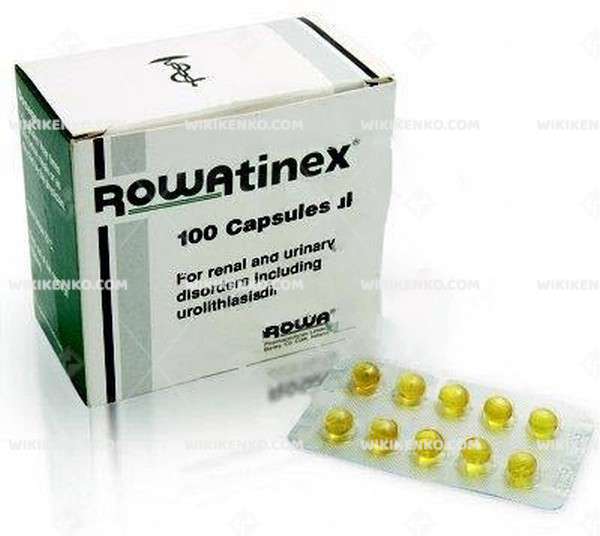Rowatinex Capsule
Rowatinex Capsules are yellow, spherical soft gelatin capsules that provide a powerful solution for individuals suffering from kidney stones and urinary tract pain. With their gastro-resistant properties, these capsules release the medicine in the intestine rather than the stomach, ensuring targeted effectiveness.
| Dosage form | |
|---|---|
| Pack size | |
| Potency | Combined |
| Manufacturer | |
| Origin | |
| Generic Name (Ingredient) | 1 Soft Gelatin Capsule, Pinene (A + B) As Active Ingredients 31 Mg, Kampfene 15 Mg, Cineol 3 Mg, Fenchone 4 Mg Borneol 10 Mg, Anethol 4 Mg. Medicinal Oil Is Available As An Adjuvant. |
Assuming your emergency circumstances for this product, visit Urgent Quotation page. Besides, for any pharmaceutical questions, please ask us in the comments section.
Description
Uses and Benefits
Dissolving Kidney and Urinary Tract Stones: Experience Relief with Rowatinex Capsules
Rowatinex Capsules contain essential oils that possess the unique ability to dissolve and eliminate kidney and urinary tract stones. By effectively breaking down these stones, Rowatinex Capsules provide relief from the discomfort and pain associated with such conditions.
Relieving Muscle Spasms: Say Goodbye to Kidney and Urinary Colic Pain
One of the significant advantages of Rowatinex Capsules is their ability to alleviate muscle spasms, reducing the intensity of kidney and urinary colic pain. By relaxing the affected muscles, these capsules provide much-needed relief to individuals experiencing such distressing episodes.
Alleviating Mild Urinary Tract Infections: Find Comfort with Rowatinex Capsules
Rowatinex Capsules offer a supplementary benefit by providing relief from the effects associated with mild urinary tract infections. With their unique formulation, these capsules can help alleviate discomfort and promote a healthier urinary tract.
Ingredients
Each Rowatinex capsule contains a precise combination of natural ingredients that work synergistically to deliver its remarkable therapeutic effects. The key ingredients include:
- Pinine (31mg)
- Campheme (15mg)
- Cineol (3mg)
- Fenchone (4mg)
- Borneol (10mg)
- Anethol (4mg)
- Olive Oil
This carefully crafted blend of ingredients ensures the potency and efficacy of Rowatinex Capsules, making them a reliable choice for individuals seeking relief from kidney stones, urinary tract pain, and associated discomfort.
Precautions for Usage
While Rowatinex Capsules offer effective relief, certain precautions should be taken into account before use:
Unsuitable for Severe Pain or Urinary Tract Infections: Rowatinex Capsules are not suitable for patients experiencing severe pain (colic), decreased urine production, or severe urinary tract infections. In such cases, it is essential to consult a healthcare professional for alternative treatment options.
Age Restrictions: Rowatinex Capsules are not intended for use in children and adolescents under 18 years of age. It is important to follow the guidance of a healthcare professional regarding suitable treatments for this age group.
Pregnancy and Breastfeeding: It is advised not to take these capsules during the first trimester of pregnancy. If you are pregnant or breastfeeding, consult your doctor before using this medication to ensure the safety of both you and your baby.
How to Take Rowatinex Capsule
To achieve the best results and maximize the effectiveness of Rowatinex Capsules, it is recommended to follow these guidelines:
Timing: Take Rowatinex Capsules on an empty stomach, approximately thirty minutes before meals. This allows for better absorption and ensures that the active ingredients can work efficiently.
Dosage: Follow the prescribed dosage as instructed by your healthcare professional. Do not exceed the recommended amount unless advised to do so by your doctor.
Duration: Take these capsules for the entire duration prescribed by your healthcare provider, even if your symptoms improve. Stopping the medication prematurely may hinder the complete resolution of your condition.
Swallowing: Swallow the capsules whole with a glass of water. Do not crush or chew the capsules, as it may alter their effectiveness.
Missed Dose: If you forget to take a dose, take it as soon as you remember. However, if it is close to the time for your next scheduled dose, skip the missed dose and continue with your regular dosing schedule. Do not double up on doses to make up for the missed one.
Side Effects
As with any medication, Rowatinex Capsules may cause side effects, although not everyone experiences them. It is essential to be aware of possible reactions and promptly seek medical advice if needed. The following side effects have been reported:
Gastric Disturbance: Some patients have reported slight and temporary stomach upset as a side effect of Rowatinex Capsules. While this occurrence is relatively uncommon, it is advisable to consult your doctor if you experience persistent gastric discomfort.
Vomiting: Although rare, instances of vomiting have been reported in a small number of patients using these capsules. If you experience persistent or severe vomiting, seek medical attention promptly.
Glycerine Sensitivity: Rowatinex Capsules contain glycerine (glycerol), which can be harmful in high doses. Excessive intake may lead to symptoms such as headache, stomach upset, and diarrhea. It is crucial to adhere to the prescribed dosage and seek medical advice if you experience any adverse effects.
Allergic Reactions: These capsules contain sodium ethyl hydroxybenzoate (E215) and sodium propyl hydroxybenzoate (E217), which may cause allergic reactions, albeit rarely and possibly with delayed onset. If you notice any signs of an allergic reaction, such as rash, itching, swelling, or difficulty breathing, seek immediate medical attention.
It is important to note that the above list may not include all possible side effects. If you experience any other unusual symptoms or if any of the side effects become severe or persistent, inform your doctor or pharmacist promptly.
Conclusion
Rowatinex Capsules provide a reliable solution for individuals suffering from kidney stones, urinary tract pain, muscle spasms, and mild urinary tract infections. By understanding the proper usage, precautions, and potential side effects, you can optimize the benefits of this medication while prioritizing your health and well-being. Remember to consult a healthcare professional for personalized advice and guidance tailored to your specific needs.
1 review for Rowatinex Capsule
Use the form below to report an error
Please answer the questions as thoroughly and accurately as possible. Your answers will help us better understand what kind of mistakes happen, why and where they happen, and in the end the purpose is to build a better archive to guide researchers and professionals around the world.
The information on this page is not intended to be a substitute for professional medical advice, diagnosis, or treatment. always seek the advice for your physician or another qualified health provider with any questions you may have regarding a medical condition. Always remember to
- Ask your own doctor for medical advice.
- Names, brands, and dosage may differ between countries.
- When not feeling well, or experiencing side effects always contact your own doctor.
Cyberchondria
The truth is that when we’re sick, or worried about getting sick, the internet won’t help.
According to Wikipedia, cyberchondria is a mental disorder consisting in the desire to independently make a diagnosis based on the symptoms of diseases described on Internet sites.
Why you can't look for symptoms on the Internet
If diagnoses could be made simply from a textbook or an article on a website, we would all be doctors and treat ourselves. Nothing can replace the experience and knowledge of specially trained people. As in any field, in medicine there are unscrupulous specialists, differences of opinion, inaccurate diagnoses and incorrect test results.



Mustapha Bhagratty –
could you tell the source of gelatin in the capsule please
Medical Guidance Center –
Hello Mustapha, this is WikiKenko.
The gelatin used in the production of the Rawatinex capsules is derived from bovine sources. Please note that the information is available on the drug packaging label and in the product information leaflet that is included with the medication.
Gelatin is commonly used in the pharmaceutical industry to make the outer shell of capsules. It helps to hold the medicine together and protect it from the environment. Gelatin is used in Rowatinex capsules to create a soft gelatin capsule that is easy to swallow and digest. The gelatin itself does not have any direct benefits for the conditions that Rowatinex is used to treat.